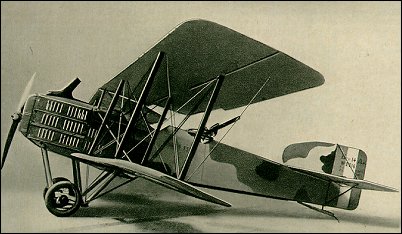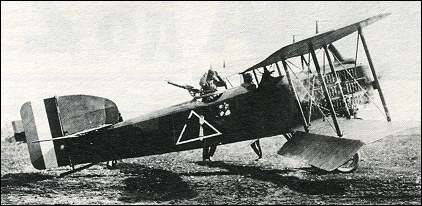|
| This aircraft was the outstanding French day bomber/reconnaissance aircraft of World War I. The Bre 14 A2 reconnaissance version and the Bre 14 B2 bomber equipped at least 71 French escadrilles on the Western Front by November 1918 and were also used by units in Serbia, Greece, Macedonia and Morocco. The prototype flew for the first time on 21 November 1916. Production was spread over seven manufacturers, in addition to the Louis Breguet factory at Velizy, near Paris, and some 8,000 of the type were built up to 1926.
A robust two-bay unequal-span biplane of mixed construction, it was remarkable for its time in the amount of duralumin used in the fuselage and wing structure. Covering was of fabric. The metal cowling over the 238.5kW Renault 12Fe engine was extensively louvred and a distinctive frontal radiator was fitted. The Bre 14 A2 was armed with a single fixed 7.7mm Vickers machine-gun on the left side of the fuselage and twin Lewis guns in the observer's cockpit. The B2 version could be fitted with an additional Lewis gun that fired downwards through the rear fuselage floor and had a maximum bomb load of 256kg, carried on underwing racks.
The reconnaissance version was followed into production by the bomber in the summer of 1917, the latter differing in having Breguet-designed automatic trailing-edge flaps on the lower wings and transparent panels in the sides of the observer's cockpit. Late production examples of both versions had horn-balanced ailerons, the B2 aircraft thus equipped doing away with the trailing-edge flaps. A single-seat long-range version, known as the Bre 14 B1, was also built in limited numbers during 1918, and was intended to bomb Berlin. In fact it was little used and never mounted an attack on the German capital. Breguet 14 also equipped American and Belgian units during World War I, some powered by Italian Fiat A-12 and A-12bis engines.
Breguet 14 remained in service in the colonial/TOE version throughout the 1920s, equipping many overseas units. A number of foreign countries also flew the type. Many ex-French aircraft were handed over to Poland in 1919 and these took part in the fighting with Russia in 1920. The type formed part of the initial equipment of the Czech air arm, and others were operated in Brazil, China (70 with 298kW Lorraine-Dietrich engines), Denmark, Finland, Greece, Japan, Portugal and Spain. The Spanish equipped four squadrons in Morocco in 1922, using them on missions against Riff tribesmen. A further 40 were obtained in 1923. A small number of float variants were also built, mostly with a central main float and small wingtip stabilising floats.
During 1919 Breguet 14 made a number of remarkable long-distance flights and Louis Breguet founded the Compagnie des Messageries Aeriennes with them, making regular air mail flights linking Paris with Brussels and London. These Bre 14 had special mail containers fitted under the wings. A cabin version with provision for two passengers was built as the Breguet 14T.
Later came the improved Bre 14Tbis and the three-passenger Breguet 14T2. During the 1920s, the Lignes Aeriennes Latecoere company used more than 100 Breguet 14 in various versions on its routes between Toulouse and Dakar (West Africa) and between Natal and Santiago di Chile in South America. The final version worthy of mention was the 14S air ambulance, adapted from the Breguet 14T. This version was widely operated in the 1920s during the campaigns in Morocco and Syria. Each could carry two stretchers in the rear fuselage.
| CREW | 2 |
| ENGINE | 1 x Renault 12Fcx, 220kW |
| WEIGHTS |
| Take-off weight | 1740 kg | 3836 lb |
| Empty weight | 1140 kg | 2513 lb |
| DIMENSIONS |
| Wingspan | 14.4 m | 47 ft 3 in |
| Length | 9.0 m | 30 ft 6 in |
| Height | 3.3 m | 11 ft 10 in |
| Wing area | 49.0 m2 | 527.43 sq ft |
| PERFORMANCE |
| Max. speed | 180 km/h | 112 mph |
| Ceiling | 6000 m | 19700 ft |
| Range | 900 km | 559 miles |
| ARMAMENT | 3 machine-guns, 300kg of bombs |
| Slawomir Bialkowski, e-mail, 09.04.2025 13:57 In Poland.
Karol Aleksander Bronisław Borzęcki, a French citizen of Polish origin, accepted an offer from the Indochina authorities to work on the country's cartography at the end of 1919. In connection with this, he made many flights aboard a Breguet XIV aircraft. This allowed him to use his qualifications as an aviator and as a photographer. In October 1922, he patented a solution for a device that provided automatic and continuous aerial photography. In 1929, he headed the Indochina aerial photography service in Hanoi.
The Polish Air Force had 158 Breguet XIV aircraft (according to [1]). At that time, it was the largest group of aircraft of one type in the Polish Air Force. The first arrived at the beginning of May 1919 as part of the Polish Army of General Józef Haller. There were 45 units: 26 Breguet XIVA2 (including 20 units in 39 E. Br and 59 E. Br), 18 Breguet XIVB2 (including 15 units in 66 E. Br), the rest in reserve in V /F /RPL and 1 Breguet XIVA2GR of the French Military Mission. The squadrons were introduced in 1919 to the composition of the Polish Air Force, assigning them Polish numbering.
In April and June 1919, two Breguet XIV aircraft (one each in the A2 and B2 versions) received from the French were used in the air squadron of the 4th Division of General Żeligowski in Romania.
The Polish Military Purchasing Mission operating in Paris in 1919-1920 ordered 186 Breguet XIV aircraft from France. Two orders were withdrawn, ultimately bringing in 110 aircraft, including 70 in the A2 version and 40 in the B2bis version. In February 1920, the Breguet XIV aircraft was selected as the typical aircraft of this class for Polish military aviation. The last purchased aircraft reached Poland in the spring of 1921. In 1926, an additional 1 medical aircraft, the Breguet XIVTbis, was purchased. In addition to the three French squadrons mentioned above: 39 E. Br., 59 E. Br. and 66 E. Br., Breguet XIV aircraft were the basic equipment of the 3 EW and 10 EW squadrons and 16 EW (former 39 E. Br.) and 17 EW (former 59 E. Br.). The 66 E. Br. squadron equipped with the bomber version was included in OSOL. These aircraft were then in the Toruń EW and later in the 4th EW. Smaller numbers of Breguet XIV aircraft were also in the reconnaissance squadrons: 1, 2, 5 and 11. Breguets took part, among others: in the 1919 offensive on Lutsk, in reconnaissance flights over Upper Silesia, Zaolzie, Spisz, Orava and the Poprad Valley, in the spring offensive in 1920 in Ukraine (the 3rd and 16th EW were stationed, among others, in Kiev), the offensive on Zhlobin and Gomel, in battles on the Southern Front, in the Battle of Warsaw in August 1920, the offensive on Grodno, the Battle of the Niemen, in the operation on Lida and in operations in the Vilnius region in General Żeligowski's group. Individual aircraft were used as disposable in the French Pilot School in Warsaw, in the French Military Mission, the NDWP Aviation Command and in the commands of the Fronts, groups and air divisions. After the war, these aircraft were in the equipment of the 3.12 16 EW and the subsequent ones created in their place from 1921, constituting the basic equipment of the reconnaissance squadrons of the 1st PL. They were gradually replaced until 1926, when they were withdrawn from the last 13 EL (former 3 EW) in the 1st PL. In 1928, they were assigned to the newly formed 211 EB from the 1st PL. As training and towing aircraft, they served in the training squadrons of individual air regiments. Breguet XIVs were used for training pilots, observers, gunners and mechanics at WSP Grudziądz, OSOL Toruń, OSL Dęblin, CWOL Dęblin, LSSiB Grudziądz, CSPPL Bydgoszcz and the Aviation Service Branch in Poznań. They were experimental in the equipment of: the Military Aviation Research Centre - Experimental Section, later at the Institute of Aviation Technical Research, at the Military Gas Institute and at the Balloon and Parachute Factory. At CWL, and later at WCZL, several units were modified to a long-range version. Many were converted to training aircraft, corresponding to the Breguet XIVE2 standard, and several to medical aircraft, corresponding to the Breguet XIVS version. Modifications were made to experimental aircraft for testing parachutes and test spreading insecticides. On 31.05.1921, an agreement was concluded with S.A. Francopol Automotive and Aviation Works for the construction of, among others, 200 Breguet XIVB2 aircraft. The factory was to start producing airframes by the end of 1922 and engines at the beginning of 1923. The agreement was not fulfilled due to the fault of SA Francopol.
In April 1925, a Breguet XIVTbis ambulance aircraft was ordered in France. The purchase was made with contributions from members of the Polish General Pharmaceutical Society. The aircraft, delivered in April 1926, was in the inventory of 1 PL until 1928.
The number of Breguet XIV aircraft was constantly decreasing. In December 1927 there were ... reply | | Barry, 27.03.2013 16:56 Some 5,500 were produced before the war's end but this pales when it is considered that some 8,370 were produced when production ceased in 1926. reply | | Klaatu83, e-mail, 02.01.2012 15:41 Although the Bre.14 appears to be a typical aircraft of the WW-I era, it was not. Unlike most of it's contemporaries, which were made of wood, the Bre.14 was fabricated mainly from light metal alloy. As a result it was much stronger, and a good deal less heavy, than it appeared to be. In addition, the aluminum didn't tend to deteriorate quickly, as wooden aircraft structures often did. Small wonder that these planes remained in service so long after the end of the war, after most other WW-I era aircraft had been scrapped! reply | | daxiang, 20.06.2011 05:03 it brought many crtics to those high ranks officers, however, I can feel its classic feeling everytimes I visited this replica. reply | |
| | Mark Shilling, e-mail, 08.05.2011 02:30 My Grandfather also flew the Breguet 14B2 in WW1. He flew in the 96th Aero Squadron. Had lots of good stories to tell. reply | | Bubba Shaffer, e-mail, 13.02.2011 15:56 My grandfather Harry E Shaffer flew this plane in WWI for the french. I think Squad 66? I would like all the info that is available on him and this plane. Are there any in existance still? I would like to build or buy a model of this plane for my father this year for father's day. Thank you, Bubba Shaffer Orlando FL reply | | chaiwat kosatanakom, e-mail, 30.08.2009 17:10 We have got a replica here in the RTAF museum. Many years ago, we traded this replica with our remaining Bearcat. Of course, it brought many crtics to those high ranks officers, however, I can feel its classic feeling everytimes I visited this replica. reply | | jesse galvez, e-mail, 07.06.2009 22:57 did the cockpit of this plane have a breguet time instrument? or was that timepiece placed in another breguet plane? reply |
|
Do you have any comments?
|
| 
COMPANY
PROFILE
All the World's Rotorcraft
|







